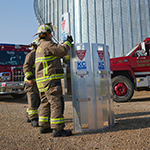Reduce bin entry risk with lockout/tagout procedures
Working in and around grain bins is dangerous. Adding safe bin-entry procedures can help reduce the risk of grain entrapment, engulfment and entanglement. A lockout/tagout is an example of these procedures
What is lockout/tagout
A lockout/tagout is a simple, inexpensive combination of tools and processes that helps ensure all powered equipment is shut down and poses no harm to workers. This enables workers to perform bin maintenance safely and securely and free of hazards caused by these different types of energy:
- Electrical
- Mechanical
- Gravitational
- Chemical
- Thermal
- Pneumatic
- Hydraulic
- Wind
Know your working conditions
Employing a lockout/tagout system starts with an assessment of your surroundings and working conditions. Before entering a grain bin, flat storage structure or grain pile, perform a thorough assessment to determine potential risk factors that you can control. This helps confirm specific equipment to power down before a worker enters a bin based on these variables:
- Grain condition
- Grain height
- Bin atmosphere
- Filling methods
- Auger or drag conveyor use
Find the right lockout/tagout systems
Once you’ve identified the specific components to power down before conducting maintenance or working inside a bin, it’s time to get locking mechanisms to the controls for those systems to ensure they can’t be activated. Kits can be purchased to include all necessary locks, with prices ranging from $100 to $1,000 depending on the number of locks and types of equipment where they’ll be installed. A wide array of individual or group kits and individual items are available from retailers, such as Brady, Grainger, Master Lock and Zing.
Five steps to locking out powered equipment
Once you’ve secured and installed locks to all necessary components and systems, follow these five simple steps:
- Notify all affected co-workers that equipment will be locked out.
- Shut down the equipment using the normal stopping procedure.
- Isolate the energy via the switch, valve or other energy isolating device, such as a circuit breaker.
- Apply the lock(s). Each person working on the equipment should apply a lock and retain the key.
- Verify de-energization by attempting to start the equipment. After testing, return the operating control to the “neutral” or “off” position.
Repeat these steps for each piece of equipment that needs to be de-energized and powered down. For example, before entering a grain bin, you may need to lock out an unload auger/drag conveyor, fill auger/drag conveyor, elevator leg and/or distributor.
When tag out is the only option
If you are unable to lock out equipment, you may tag out instead. The tagout process involves applying a durable tag that illustrates a safety level similar to a lockout. A highly visible tag attached to powered components or systems should identify who applied it, warn against the hazards of energizing the equipment and include a one of these labels:
- Do not start
- Do not open
- Do not close
- Do not energize
- Do not operate
Once you have attached either all necessary locks or tags, be sure to document all lockout/tagout steps and share with anyone who might be working on or around bins or their powered components. See more steps to establishing a lockout/tagout for your bins.
Removing lockout/tagout devices
After all work is complete, follow these steps when removing lockout/tagout devices:
- Inspect the area and remove all rags, tools or anything else used during the work.
- Ensure everyone is accounted for and the equipment is safe to operate.
- Alert all effected co-workers that energy will be restored.
- Verify that controls are in the “neutral” or “off” position.
- Remove lockout/tagout devices and re-energize the equipment. Only the individual(s) who applied the lock(s) should remove them.
- Notify all affected co-workers that the equipment is in use or ready to use.
Create a safe workplace
Taking the time to properly implement and follow lockout/tagout procedures before entering grain bins can help reduce the risk of entrapment, engulfment and entanglement. This simple, inexpensive method offers priceless safety benefits to you and your co-workers. See more ways to manage risk when working around grain bins.
Lean more about Nationwide agribusiness insurance. Find a farm agent.

 >
>

 >
>
 >
>